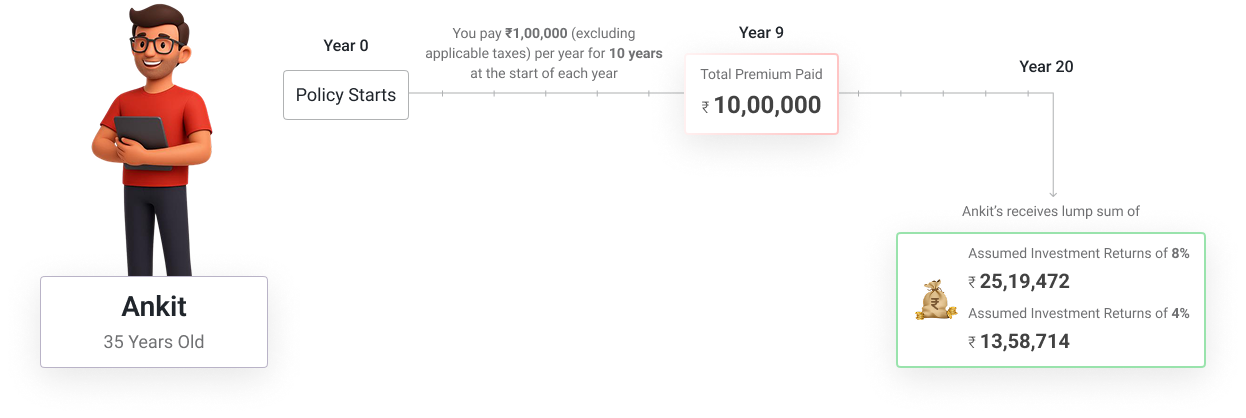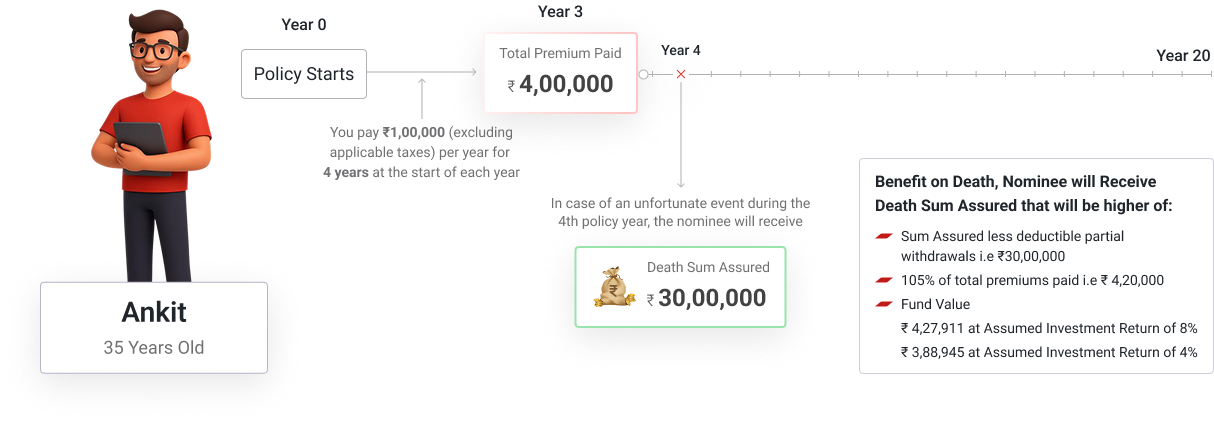Future Generali India Life Insurance Company Limited is now Generali Central Life Insurance Company Limited. Generali Central Life Insurance Company Limited – A joint venture between Generali – one of the world’s leading insurers and Central Bank of India, India’s finest nationalised bank.
Future Generali India Life Insurance Company Limited is now Generali Central Life Insurance Company Limited. Generali Central Life Insurance Company Limited – A joint venture between Generali – one of the world’s leading insurers and Central Bank of India, India’s finest nationalised bank.
Why Choose Generali Central Sampoorna Samadhaan Plan?
This is an Individual, Non-Participating (without profits), Unit Linked, Life Insurance Plan.
A secure future is not just about growing money — it’s about knowing your family will always be protected. Sampoorna Samadhaan brings you the dual advantage of wealth creation and comprehensive life cover, all in one plan.
With charges refunded back, easy withdrawals, and the freedom to manage your funds your way, this plan gives you complete control over your financial journey. It’s the assurance you need to face life’s uncertainties while staying on track with your dreams.
Because true peace of mind comes when your solution is as complete as your goals.

Flexible Fund Management
Switch freely or opt for automated fund allocation

Easy Monthly Withdrawals
Get monthly payouts to meet specific financial needs

Refunded Charges
Enhance your savings with refunded mortality and allocation charges

Tax Benefits
Enjoy tax benefits under current tax laws

Add Extra Safety
Enhanced protection for accidental death & disability through riders

Comprehensive Protection
Life cover secures your loved ones against uncertainties
Get Expert Advice from Your Trusted Life Insurance Partner!
Have questions? Get help and reliable support from experts at Generali Central Life Insurance.
Fund Options
Depending on your investment risk appetite, choose from any of the following 9 funds. Your premium, net of applicable charges, if any, is invested in funds of your choice. The funds, in turn, are segregated into liquid investments, fixed income securities and equity investments in line with their risk profile.
Future Secure Fund (SFIN: ULIF001180708FUTUSECURE133) Investments in assets of low risk
The investment objective of this fund is to provide stable returns by investing in relatively low risk assets. The fund will invest exclusively in treasury bills, bank deposits, certificate of deposits, other money market instruments and short duration govt. securities
| Composition | Min. | Max. | Risk Profile |
|---|---|---|---|
| Money Market Instruments | 0% | 75% | Low |
| Short Term Debt | 25% | 100% |
Default Fund
A segregated fund can be closed with prior approval from IRDAI. In case the existing fund is closed, the default fund is the Future Income Fund (SFIN: ULIF002180708FUTUINCOME133).
In case any existing fund is closed, the company shall seek prior instructions from the policyholder for switching units and for future premium re-directions from the existing closed fund to any other available fund under the plan.
If the Company does not receive the choice of the fund from the policyholder, the Company shall transfer the units of the policyholder from the fund which is intended to be closed to the Future Income Fund (SFIN: ULIF002180708FUTUINCOME133). All future premium re-directions related to the closed fund shall be redirected to the Future Income Fund (SFIN: ULIF002180708FUTUINCOME133).
Modification of Fund
A segregated fund can be modified with prior approval from IRDAI.
In case any existing fund is modified, the company shall seek prior instructions from the policyholder for switching units and for future premium re-directions from the existing modified fund to any other available funds under this plan.
On such modification of the fund, if the company does not receive the choice of the fund from the policyholder, the company shall continue to invest in such a modified fund.
Eligibility
Choose the plan that fits your life
18 to 65 years (as on last birthday)
38 to 85 years (as on last birthday)
Annual
Minimum - ₹50,000 Annually
Maximum - No limit, As per Board Approved
Underwriting Policy
20, 30, 40, 50 years
Limited and Regular Pay
Sum Assured is defined as: Death Benefit Multiple X Annualized Premium (excluding taxes, rider premiums and underwriting extra premium on riders, if any). The minimum Death Benefit Multiple available are:
The maximum Death Benefit Multiple which can be opted upto 100 depends on Age, Annualized Premium, Policy Term and Premium Payment Term you have chosen, subject to Board Approved Underwriting Policy. Please refer to the Death Benefit Multiple as mentioned in product brochure.
Benefits of Generali Central Sampoorna Samadhaan Plan
Here’s how this plan helps you secure your goals and safeguard your loved ones:
A lump sum amount payable at the end of the policy term, provided all due premiums have been paid.
On policy maturity (end of policy term), you will receive your Fund Value.
Ankit’s Example
To clearly understand how the maturity benefit works, let us take a look at Ankit’s story.
Ankit is 35 years old and has chosen to invest in Generali Central Sampoorna Samadhaan Plan, with a Policy Term of 20 years, an annual premium of Rs. 1,00,000 for 10 years. His Death Benefit Multiple is 30 times and a Sum Assured (cover amount) of Rs. 10,00,000.


Note:
For the purpose of illustration, we have assumed 8% p.a and 4% p.a as the higher and lower values of investment returns. These rates are not guaranteed, and they are not the upper or lower limits of returns of the Funds selected in your policy, as the performance of funds depends on several factors including future investment performance. These rates in no way signify our expectations of future returns and the actual returns may be higher or lower.
A payment made to your nominee in case of your unfortunate demise during the policy term, ensuring your family’s financial protection.
In case of your unfortunate demise, the Death Benefit in this plan secures your family’s financial well-being and future. The Death Benefit varies as per the age, Policy Term, Premium Payment Term, Death Benefit Multiple and Annualized Premium you choose. The Death Benefit payable to the nominee shall be the higher of:
- Sum Assured less deductible partial withdrawals, if any, OR
- Fund Value under the policy, OR
- 105% of the total premiums paid (including top-up premiums paid, if any) till the date of death less deductible partial withdrawals, if any is payable.
The Sum Assured is defined as Death Benefit Multiple * Annualized Premium.
Deductible Partial Withdrawals are Partial Withdrawals made in the 2 years prior to the date of death of the Life Assured.
The Policy will terminate on the payment of Death Benefit.
Ankit’s Example
To clearly understand how death benefit works in this case, let us look at Ankit’s story
Ankit is 35 years old, and has invested in Generali Central Sampoorna Samadhaan Plan, with a Policy Term of 20 years and Death Benefit Multiple is 30 times. In case of Ankit’s unfortunate death after having paid just 4 premiums, the following illustration shows what his nominee will get:


Note:
For the purpose of illustration, we have assumed 8% p.a and 4% p.a as the higher and lower values of investment returns. These rates are not guaranteed, and they are not the upper or lower limits of returns of the Funds selected in your policy, as the performance of funds depends on several factors including future investment performance. These rates in no way signify our expectations of future returns and the actual returns may be higher or lower.
Our Promise is Reflected in the Lives We've Touched
We bring experience, stability, and a proven approach to supporting your family and financial goals.
 6019
6019Our and Partners Branches
 897,635
897,635Lives Protected
Since Inception ₹87.84 Bn
₹87.84 Bnof Assets Under Management
 98.08%
98.08%Individual Claim Settlement Ratio
FY 24-25 99.78%
99.78%Group Claim Settlement Ratio
FY 24-25Data as on 31st March, 2025
Downloads
Everything you need to understand your policy, plan your future, and make informed decisions at your convenience.
Important Information & Resources
Understand your policy better with key details and insights into the Generali Central Sampoorna Samadhaan Plan.
Refund of Mortality Charges
a) For Policyholders aged 60 and below: We shall add two times the Mortality Charge (excluding extra underwriting charges) deducted in the 120th month prior to your Fund Value, starting from the 11th Policy Year at the end of each policy month till the end of the Policy Term, provided the policy is in force and all due premiums have been paid. For instance, in the 121st policy month, your fund gets an addition equal to twice the Mortality Charges deducted (excluding extra underwriting charges) in the 1st policy month.
b) For Policyholders aged above 60: We shall add one time the Mortality Charge (excluding extra underwriting charges) deducted in the 120th month prior to your Fund Value, starting from the 11th Policy Year at the end of each policy month till the end of the Policy Term, provided the policy is in force and all due premiums have been paid. For instance, in the 121st policy month, your fund gets an addition equal to the Mortality Charges deducted (excluding extra underwriting charges) in the 1st policy month.
This amount will be allocated among the funds in the same proportion as the value of total units held in each fund at the time of allocation.
Refund of Allocation Charges
a) For Policyholders aged 60 and below: We shall add two times of Allocation charge at the end of 10th, 11th, 12th and 13th policy years, which were deducted 10 years prior (i.e. over policy years 1, 2, 3 & 4 respectively) to Your Fund Value in the form of addition of Units. Such additions shall be payable if the Policy is in force and all due premiums till date of addition have been paid.
b) For Policyholders aged above 60: We shall add one time of Allocation charge at the end of 10th, 11th, 12th and 13th policy years, which were deducted 10 years prior (i.e. over policy years 1, 2, 3 & 4 respectively) to Your Fund Value in the form of addition of Units. Such additions shall be payable if the Policy is in force and all due premiums till date of addition have been paid.
This amount will be allocated among the funds in the same proportion as the value of total Units held in each fund at the time of allocation.
Premium Allocation Charge
The premium allocation charge will be deducted from the premium amount at the time of premium payment and the remaining premium will be used to purchase units in various investment funds according to the specified fund allocation.

Lock In Period
Lock-in Period means the period of five consecutive completed years from the date of commencement of the policy, during which period the proceeds of the policies cannot be paid by the insurer to the policyholder or to the insured, as the case may be, except in the case of death or upon the happening of any other contingency covered under the policy.
Discontinuance
“Discontinuance” means the state of a policy that could arise on account of surrender of the policy or non-payment of the premium due before the expiry of the grace period.
Provided that no policy shall be treated as discontinued on non-payment of the said premium if, within the grace period, the premium has not been paid due to the death of the insured or upon the happening of any other contingency covered under the policy.
Suicide
In case of death of Life Assured due to suicide within 12 months from the date of commencement of the policy or from the date of revival of the policy, as applicable, the nominee or the beneficiary of the policyholder shall be entitled to the fund value, as available on the date of intimation of death.
Further, any charges other than Fund Management Charges (FMC) and Guarantee Charges recovered subsequent to the date of death shall be added back to the fund value as on the date of intimation of death.
Grievance Redressal Processes
In case you have any grievances on the solicitation process or on the Product sold or any of the Policy servicing matters, you may approach the Company in one of the following ways:
- Calling the Customer helpline number 1800-102 2355 for assistance and guidance
- Emailing at care@generalicentral.com
- You may also visit us at the nearest Branch Office. Branch locator - https://www.generalicentrallife.com/branch-locator
- Senior citizens may write to us at the following ID: senior.citizens@generalicentral.com for priority assistance
- You may write to us at: Customer Services Department- Generali Central Life Insurance Company Limited, Unit 801 and 802, 8th floor, Tower C, Embassy 247 Park, L.B.S Marg, Vikhroli (W), Mumbai – 400083
We will provide a resolution at the earliest. For further details please access the link: https://www.generalicentrallife.com/customer-service/grievance-redressal-procedure
Generali Central Life Insurance Company Limited (Formerly known as Future Generali India Life Insurance Company Limited) offers a wide range of life insurance solutions designed to protect and empower individuals at every stage of life. Whether it’s protecting your loved ones, planning for retirement, or securing long-term financial well-being, our offerings are designed to evolve with your needs. Backed by a robust distribution network and advanced digital tools, we are dedicated to delivering simplicity, innovation, empathy, and care in every experience — all anchored by our unwavering commitment to being your Lifetime Partner.
This commitment is backed by the strength of our joint venture between Generali, a global insurance leader with over 190 years of expertise, and Central Bank of India, a trusted name with a rich legacy in Indian banking.
- Unit Linked Insurance plans are different from traditional insurance plans and are subject to risk factors.
- The Premium paid in Unit Linked Insurance policies are subject to investment risks associated with capital markets and the NAVs of the units may go up or down based on the performance of the fund and factors influencing the capital market. The policyholder/insured is solely responsible for his/her decisions.
- Generali Central Life Insurance Company Limited is only the name of the Insurance Company and Generali Central Sampoorna Samadhaan Plan is only the name of the Unit Linked Life Insurance contract and does not in any way indicate the quality of the contract, its prospects or returns.
- Please know the associated risks and the applicable charges from your insurance agent or the intermediary or policy document of the Company.
- The various funds offered under this contract are the names of the funds and do not in any way indicate the quality of these plans, their prospects and returns.
- Past performance is not indicative of future performance, which may be different. The investments in the Units are subject to market and other risks and there can be no assurance that the objectivities of any of the funds will be achieved. The funds do not offer guaranteed or assured return.
- Tax benefits are subject to change in law from time to time. You are advised to consult your tax consultant.
- The linked insurance plans do not offer any liquidity during the first five years of the contract.
- The policyholder will not be able to surrender/withdraw the monies invested in linked insurance plans completely or partially till the end of the fifth year.
Generali Central Life Insurance Company Limited (formerly known as Future Generali India Life Insurance Company Limited) (IRDAI Regn. No. 133)
Regd. and Corporate Office address: Unit 801 and 802, 8th floor, Tower C, Embassy 247 Park, L.B.S. Marg, Vikhroli (W), Mumbai – 400 083.
Email - care@generalicentral.com
Call us at - 1800-102-2355
Website: www.generalicentrallife.com
UIN: 133L102V01
ARN: ADVT/Comp/2025-26/October/3791
Generali Group’s and Central Bank of India’s liability is restricted to the extent of their shareholding in Generali Central Life Insurance Company Limited. For detailed information on this plan including risk factors, exclusions, terms and conditions etc., please refer to the policy document and consult your advisor, or, visit our website (www.generalicentrallife.com) before concluding a sale.
What Our Happy Customers Are Saying
Real stories, real people— hear from those who’ve taken the step of strengthening their financial security with us.
Got Questions? We’ve Got Answers!
Here are answers to some of the questions you might have.
This is a Unit Linked Insurance Plan (ULIP) that combines life insurance protection with investment opportunities. You can build wealth while providing life coverage for your family's financial security in one comprehensive plan.
The plan offers 9 different funds across risk categories. Low-risk options include Future Secure Fund and Future Income Fund. Moderate-risk includes Future Balance Fund and Future Income Plus Fund. High-risk options include Future Maximize Fund, Future Apex Fund, Future Opportunity Fund, Future Midcap Fund, and Future Multi-cap Equity Fund.
Self-Invest Rule allows you to decide your fund allocation strategy yourself. Auto-Invest Rule provides pre-defined automated allocation based on either your current age or the number of years remaining to policy maturity.
The plan refunds twice the mortality charges starting from Year 11 (for policyholders aged 60 and below) and refunds twice the allocation charges in Years 10-13 (for policyholders aged 60 and below), effectively adding money back to your investment corpus.
You can surrender, but the fund value after discontinuance charges will be transferred to a Discontinued Policy Fund and paid only after the 5-year lock-in period expires.















